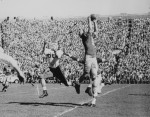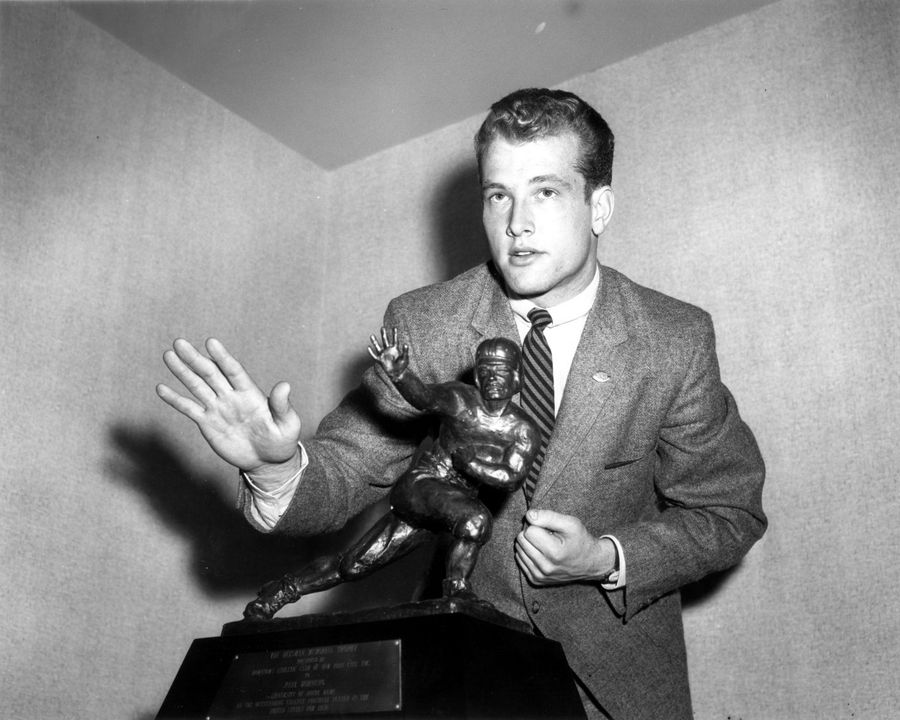Oct. 20, 2006
By Lou Somogyi
Often imitated in title but never duplicated on or off the field, Paul Hornung remains Notre Dame’s original “Golden Boy.”
That same title was bestowed upon Rick Mirer by Sports Illustrated in 1990 when the sophomore’s initial start resulted in a 28-24 victory over Michigan. Like Hornung, Mirer possesses blond coifs. Like Hornung, Mirer was recruited as a quarterback.
However, there can be only one original. Hornung is also an original in that there never was and never will be a Heisman Trophy winner like him.
Today, there are three unofficial stipulations needed to receive the award.
- Playing for a national title contender or at least a team ranked in the top 10. Twelve of the last 15 recipients played on teams with zero or just one loss at the time of the voting, and none had a worse record than 8-3.
- Impressive, if not gaudy, statistics, preferably on offense.
- Defining games on television that capture the nation’s imagination.
Fifty years ago, on Dec. 5, 1956, those three criteria were rendered meaningless when Hornung captured the most coveted individual prize in college athletics. His 1,066 points in the balloting edged Tennessee’s Johnny Majors’ 994 for top honors.
Playing for a national title contender?
In 1956, Notre Dame had its worst season ever, finishing 2-8 while getting out-scored 289-130. Meanwhile, Majors had led Tennessee to a 10-0 regular season mark and a No. 2 finish nationally, behind Oklahoma.
Finishing third and fourth in the Heisman balloting were two Oklahoma products, Tom McDonald and Jerry Tubbs, who led the Sooners to their third consecutive unbeaten season and second straight national title.
No way that could happen today.
How about posting mind-boggling stats?
Hornung’s numbers in 1956 were relatively modest. As a quarterback, he completed 59-of-111 passes (53.1 percent) for 917 yards, 13 interceptions and only three TDs.
Compare that to Stanford’s John Brodie, who finished seventh in the ’56 balloting: 139-of-240 (57.9 percent) for 1,633 yards, 14 interceptions and 12 TDs. (Stanford finished 4-6.)
Hornung also rushed for 420 yards on 94 attempts (4.5 yards per carry) – plus he intercepted two passes and kicked 14 extra points.
Still, Syracuse’s Jim Brown and Oklahoma’s McDonald had more glittering numbers.
Brown gained 986 yards on 158 carries (6.2 yards per carry), scored 14 TDs, kicked 22 extra points and recorded three interceptions.
McDonald rushed for 853 yards on 119 attempts (7.2 yards per carry) and scored 12 TDs.
No way that could happen today.
As for “defining” games for a national audience – such as Tim Brown’s two punt returns for scores against Michigan State in 1987 – Hornung had nothing of the sort.
The Irish had one game nationally televised in 1956 – the 40-0 whitewashing to Oklahoma in Notre Dame Stadium. The two games that were regionally televised resulted in a 33-7 pummeling at the hands of Navy and a 47-14 thrashing from Michigan State.
A 2-8 record, good but not sparkling stats, no defining moments on national television – and yet Hornung won the Heisman.
In addition to Majors, McDonald, Tubbs, Brown and Brodie, future All-Pros Ron Kramer (Michigan) and Jim Parker (Ohio State) finished in the top 8.
“I can’t believe it,” Hornung said at the time. “I didn’t think I was even up for consideration.”

Paul Hornung did it all for the Irish during his career – run, throw, kick and play defense. Here he intercepts a pass against Indiana in a 1955 game.
|
Of course, it was a different era. There was no weekly “Heisman Watch,” and candidates weren’t flown into New York City for the dramatic nationally televised announcement. Hornung said he first heard about it in a phone call from former winner and then radio broadcaster Tom Harmon.
“I was told to go to (Notre Dame sports publicity director) Charlie Callahan’s office,” Hornung recalled. “When I got there, Charlie handed me the phone and said, ‘Tell your mother you have just won the Heisman Trophy.’ “
How did Hornung win the ’56 Heisman?
Undoubtedly, the name Notre Dame had much to do with it. Hornung became the fifth Fighting Irish recipient in 13 seasons, beginning with Angelo Bertelli (1943) and continuing with John Lujack (1947), Leon Hart (1949), John Lattner (1953) and himself.
Second, Hornung had a stellar junior year, leading the Irish to an 8-2 mark and finishing fifth in the Heisman race – the highest among all non-seniors. Voters kept that in mind for ’56.
Finally, football grants-in-aid had been cut back at Notre Dame in the early 1950s, and the roster had become thinner under third-year head coach Terry Brennan, who had succeeded the legendary Frank Leahy. With Notre Dame bereft of the depth it once had, Hornung became the most versatile player in college football.
In 1956, Hornung led the Irish in seven statistical categories, and only Brodie ranked ahead of him nationally in total yards. In addition, Hornung was second nationally in kickoff returns, 15th in passing and 16th in scoring.
He lined up at quarterback, fullback and halfback, played through several injuries, kicked off and kicked extra points, punted, accounted for more than half of the team’s scoring (including all the points in the 21-14 victory over North Carolina), and was second in tackles recorded (55).
Wrote the esteemed and late Dick Schaap: “In recent years many schools have had football teams named Desire. In 1956 Notre Dame had a football team named Hornung. He passed. He tackled. He intercepted passes. Surrounded by the walking wounded, playing for a team crippled by injuries, Hornung was the whole show.”
Amid the worst of circumstances, something special was sensed even then about Hornung, a bonus pick by the hapless Green Bay Packers in the 1957 NFL draft.
With Vince Lombardi’s hiring in 1959, Hornung moved from quarterback to halfback and became the centerpiece of one of the great dynasties in sports history. Hornung led the league in scoring from 1959-1961, and he was on four Packer teams that won NFL titles.
“The thing I’m proudest of is that I made the College Hall of Fame as a quarterback and the Pro Hall of Fame as a running back,” Hornung said.
His exploits off the field made the “Golden Boy” a legend in other ways. Well before “Broadway Joe’s” arrival at New York, Hornung’s nocturnal lifestyle was there for public consumption.
“Never get married in the morning – you never know who you’ll meet that night,” Hornung once said, but now married for a couple of decades to wife Angela.
After repeatedly fining Hornung for his late-night shenanigans, the exasperated taskmaster Lombardi finally decided to raise the fine to a much higher level.
“And if you find anyone worth that much – call me,” Lombardi reportedly told Hornung.
Hornung has said that he would like his epitaph to read: “He went though life on scholarship.”
In 1956 and beyond, though, he earned everything he received, including the Heisman.
Paul Hornung By The Numbers
1 Hornung’s selection in the 1957 NFL Draft. It came down to a coin flip between the Chicago Cardinals and Green Bay Packers for the right to choose first. Hornung hoped for Chicago to win the toss because of better business opportunities and night life, but the Packers won – and ultimately, so did Hornung.
2 Dislocated thumbs Hornung played with in the latter portion of his senior year. Consequently, he shifted from quarterback to halfback (his future position in the NFL) in the finale at USC, where he returned a kickoff for a 95-yard touchdown in the 28-20 loss to the Trojans.
3 Players in Notre Dame history who finished in the top five of the Heisman Trophy balloting in back-to-back seasons. John Lujack was third (1946) and first (1947), John Lattner fifth (1952) and first (1953) and Hornung fifth (1955) and first (1956). Brady Quinn could become the fourth this season.
4 Notre Dame football players enshrined in both the College and Pro Football Halls of Fame. The select company features end Wayne Millner (1933-35), lineman/linebacker George Connor (1946-47), quarterback/halfback/kicker Hornung (1954-56) and defensive lineman Alan Page (1964-66).
5 Touchdowns scored by Hornung in 1965 during a 42-27 victory over the Baltimore Colts in a 1965 regular season game. The career-high effort was overshadowed by Gale Sayers’ six-touchdown performance in a victory at San Francisco that same day. Whenever he saw Sayers afterwards, Hornung jokingly referred to him as “the upstaging SOB.”
7 Different statistical categories Hornung led Notre Dame in during his senior year when he won the Heisman Trophy: rushing, passing, scoring, kickoff returns, punt returns, punting and passes broken up. He also was second in tackles and interceptions, and caught three passes.
8 Losses suffered by Notre Dame during Hornung’s senior year in 1956, when he won the Heisman Trophy. The 15 Heisman winners from 1991-2005 combined for 15 losses – or just one per year – when they received the award. The worst regular season finish by a winner was 8-3 for Texas’ Ricky Williams.
31 Yards per kickoff return averaged by Hornung as a senior (16 for 496 yards) – a Notre Dame single-season record (minimum 1.5 returns per game) that still stands. At No. 2 is Rocket Ismail in 1989 with a 29.5 average (17 for 505) and No. 3 is Tim Brown in 1986 at 28.6 (27 for 773).
176 Points scored by Hornung during the 1960 NFL regular season – a record that still stands. Hornung scored 15 touchdowns, booted 15 field goals and added 41 PATs. Just as amazing is the point total was accomplished when the NFL was playing just a 12-game regular season.
1,337 Total offense yards produced by Hornung as a Notre Dame senior, finishing second nationally to Stanford’s John Brodie. As a junior, Hornung finished fifth in the same category with 1,215 yards.







